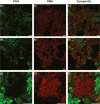Visualization of Polyhydroxyalkanoate Accumulated in Waste Activated Sludge
- PMID: 37474498
- PMCID: PMC10399201
- DOI: 10.1021/acs.est.3c02381
Visualization of Polyhydroxyalkanoate Accumulated in Waste Activated Sludge
Abstract
Polyhydroxyalkanoates (PHAs) can be produced with municipal waste activated sludge from biological wastewater treatment processes. Methods of selective fluorescent staining with confocal laser scanning microscopy (CLSM) were developed and optimized to evaluate the distribution of PHA storage activity in this mixed culture activated sludge microbial communities. Selective staining methods were applied to a municipal activated sludge during pilot scale PHA accumulation in replicate experiments. Visualization of stained flocs revealed that a significant but limited fraction of the biomass was engaged with PHA accumulation. Accumulated PHA granules were furthermore heterogeneously distributed within and between flocs. These observations suggested that the PHA content for the bacteria storing PHAs was significantly higher than the average PHA content measured for the biomass as a whole. Optimized staining methods provided high acuity for imaging of PHA distribution when compared to other methods reported in the literature. Selective staining methods were sufficient to resolve and distinguish between distinctly different morphotypes in the biomass, and these observations of distinctions have interpreted implications for PHA recovery methods. Visualization tools facilitate meaningful insights for advancements of activated sludge processes where systematic observations, as applied in the present work, can reveal underlying details of structure-function relationships.
Keywords: activated sludge; bioplastic; polyhydroxyalkanoate (PHA); staining; visualization.
Conflict of interest statement
The authors declare no competing financial interest.
Figures








Similar articles
-
Exploring the Limits of Polyhydroxyalkanoate Production by Municipal Activated Sludge.Environ Sci Technol. 2022 Aug 16;56(16):11729-11738. doi: 10.1021/acs.est.2c03043. Epub 2022 Jul 28. Environ Sci Technol. 2022. PMID: 35900322 Free PMC article.
-
Quantification of polyhydroxyalkanoate accumulated in waste activated sludge.Water Res. 2022 Aug 1;221:118795. doi: 10.1016/j.watres.2022.118795. Epub 2022 Jun 25. Water Res. 2022. PMID: 35785696
-
Calcium enhances polyhydroxyalkanoate production and promotes selective growth of the polyhydroxyalkanoate-storing biomass in municipal activated sludge.Water Res. 2022 Nov 1;226:119259. doi: 10.1016/j.watres.2022.119259. Epub 2022 Oct 18. Water Res. 2022. PMID: 36323202
-
Bioplastic polyhydroxyalkanoate conversion in waste activated sludge.J Environ Manage. 2024 Nov;370:122866. doi: 10.1016/j.jenvman.2024.122866. Epub 2024 Oct 11. J Environ Manage. 2024. PMID: 39405858 Review.
-
Scaling-up microbial community-based polyhydroxyalkanoate production: status and challenges.Bioresour Technol. 2021 May;327:124790. doi: 10.1016/j.biortech.2021.124790. Epub 2021 Feb 8. Bioresour Technol. 2021. PMID: 33582521 Review.
Cited by
-
A review on microbes mediated resource recovery and bioplastic (polyhydroxyalkanoates) production from wastewater.Microb Cell Fact. 2024 Jul 1;23(1):187. doi: 10.1186/s12934-024-02430-0. Microb Cell Fact. 2024. PMID: 38951813 Free PMC article. Review.
-
Exploring the Limits of Polyhydroxyalkanoate Production by Municipal Activated Sludge.Environ Sci Technol. 2022 Aug 16;56(16):11729-11738. doi: 10.1021/acs.est.2c03043. Epub 2022 Jul 28. Environ Sci Technol. 2022. PMID: 35900322 Free PMC article.
-
Bio-Based and Biodegradable Polymeric Materials for a Circular Economy.Polymers (Basel). 2024 Oct 28;16(21):3015. doi: 10.3390/polym16213015. Polymers (Basel). 2024. PMID: 39518225 Free PMC article. Review.
References
-
- Dawes E. A.; Senior P. J.. The Role and Regulation of Energy Reserve Polymers in Micro-organisms. In Advances in Microbial Physiology; Elsevier, 1973; Vol. 10, pp 135–266. - PubMed
-
- Van Loosdrecht M. C. M.; Pot M. A.; Heijnen J. J. Importance of bacterial storage polymers in bioprocesses. Water Sci. Technol. 1997, 35, 41–47. 10.2166/wst.1997.0008. - DOI
-
- Koller M.; Rodríguez-Contreras A. Techniques for tracing PHA-producing organisms and for qualitative and quantitative analysis of intra- and extracellular PHA. Eng. Life Sci. 2015, 15, 558–581. 10.1002/elsc.201400228. - DOI
Publication types
MeSH terms
Substances
LinkOut - more resources
Full Text Sources

